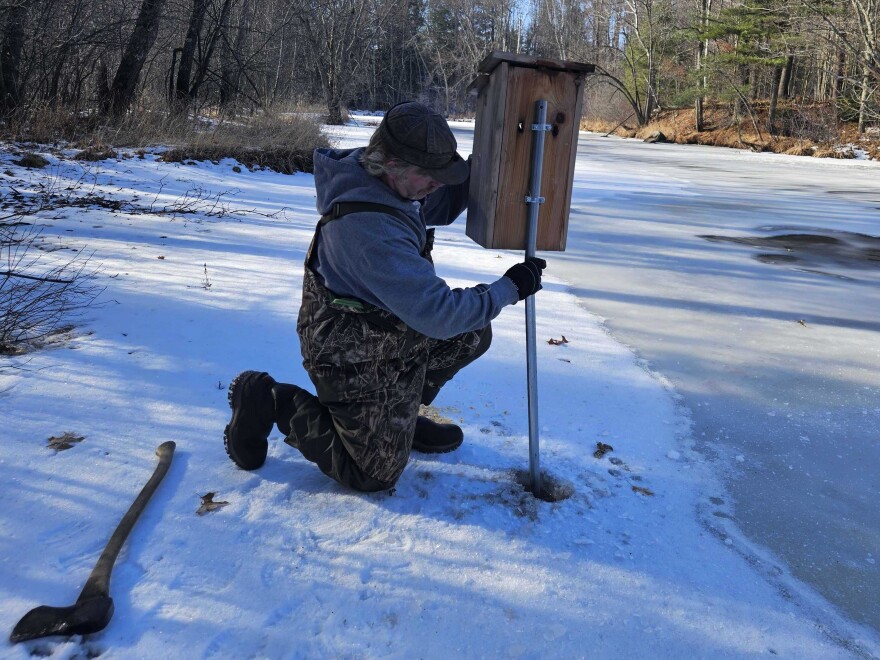Towards the end of the 1800s it looked like wood ducks were headed towards extinction.
The Migratory Bird Treaty Act of 1918 is credited with saving the species, but many also credit the invention of the wood duck box in the 1930s with their conservations.
The ones Wisconsin DNR Conservation Warden Tim Otto pulled onto the tailgate of his pickup truck look like a large, wooden birdhouse with a rectangular body, slanted roof, and a hole roughly the size of a fist on the front.
“The size of the hole should be pretty similar. If they get too big, then things other than what ducks will use them, which isn't the end of the world,” said Otto.
For Otto, it’s great if a wood duck ends up using it to lay eggs and raise ducklings.
But at the end of the day, his goal is to improve habitat for whatever wildlife might need it.
“You know, wood ducks aren't endangered, not by a longshot. In fact, the wood ducks are widely viewed as a huge conservation win, a huge conservation victory,” said Otto.
According to the American Bird Conservancy, wood duck populations were in major decline in the 1800s.
Destruction of hardwood forests took away the duck’s primary breeding and wintering habitat.
There also weren’t any kind of hunting regulations on wood ducks.
That changed with the enactment of the Migratory Bird Treaty in 1918 which put a moratorium on Wood Duck hunting across the U.S.
But that was only half the equation.

To help make up for habitat loss, two biologists, Gil Gigstead and Milford Smith, put up the first versions of wood duck boxes in 1937 in Illinois.
Over the next two years, Arthur Hawkins and Frank Bellrose put up 700 boxes throughout Illinois.
Now, wood duck boxes are used by groups and peoples throughout the U.S. to support the species.
Which is what Otto was doing last week.
While still at the truck, Otto opens the front of the box to stuff it with wood shavings.
“[It’s] supposed to be about half to two thirds full so I kind of look at it like okay, roughly when we put that on there, it's going to be close. We throw in a little compaction,” said Otto as he pressed down the shavings.
Then he screws it shut and we take it, an ax, and a pole to the Pelican River.
It’s an unusually warm February day, but with still enough ice along the banks for us to walk out on.
Otto chips a hole in the ice and then hammers a pole into the riverbed.

Otto attaches the wood duck box to pole above the river at a height that will mean the box stays dry, even at high water.
“I think the big thing is that they're going to be using the river as a travel corridor, so getting it to face some way towards the river is going to be the important part,” said Otto.
The wood duck box is installed. Now it’s just a matter of waiting for spring to see if this placement was a good one and attracted any wood ducks.
“A lot of trial and error with a specific placement, but that's kind of the fun of it, too, is if you do something wrong, and it doesn't work, well you learn something and then when you do it right, you learn something again,” said Otto. “At very least it makes for good dinner party conversations you know about what you did right and wrong.”
States across the upper U.S. are breeding grounds for wood ducks. Wood duck boxes near or over water are more likely to be used.
Certain habitats will attract them better than others.
“Like a lot of waterfowl, [they want] shallow, swampy waters. They'll eat seeds, but they also eat invertebrates and stuff. In this part of the world, they really like acorns, so anywhere that there's some oaks hanging over the water, which I think we've got here,” said Otto. “The spot being a river spot, not necessarily the moving waters that's going to be the appeal, but there's a lot of these little slack water areas, little back bays, that intermittently flooded stuff, that's fantastic waterfowl and wood duck habitat.”

Otto suggests if you don’t have a place to install a wood duck box, you can always adopt one, just make sure you have permission from the landowners, whether it’s private or public.
And don’t forget to check it and clean it annually.
“It might be other things using it too. At the very least, again, it's kind of kind of fun to watch and see what else uses what else uses cavities to nest,” said Otto.
Ducks Unlimited offers resources on how to build and install a wood duck box.









